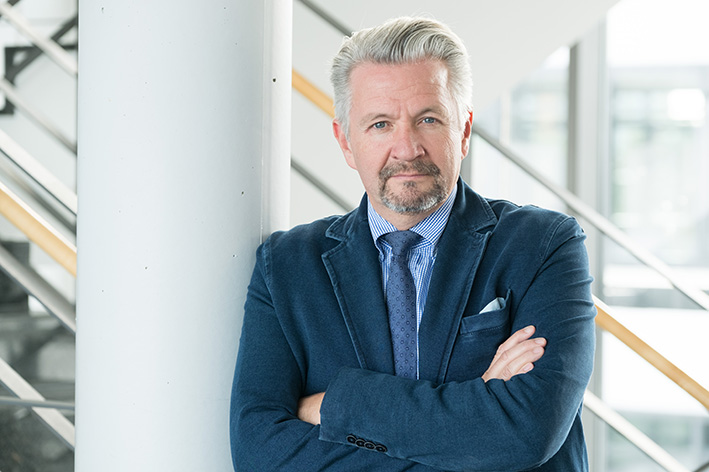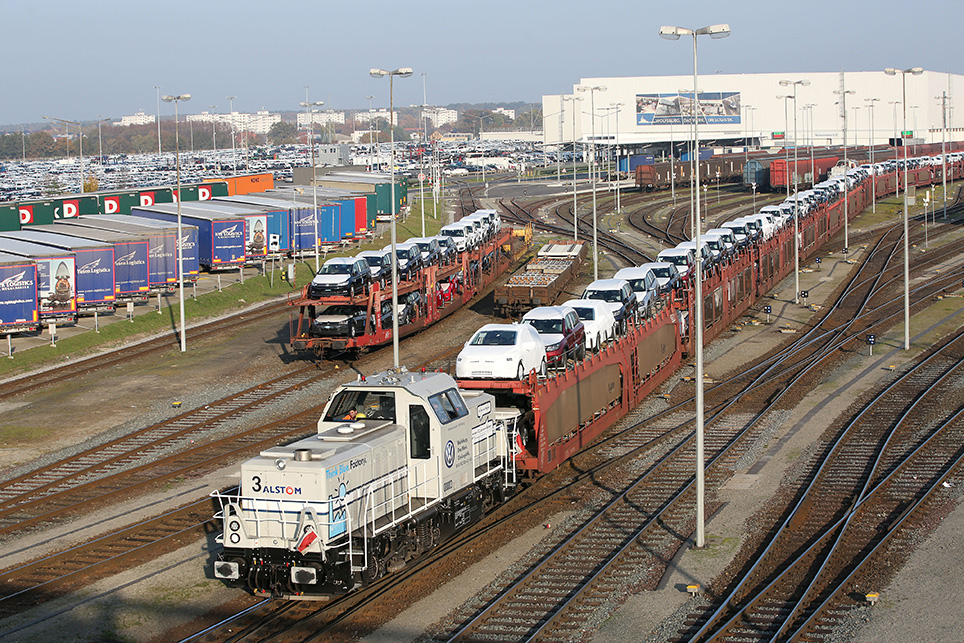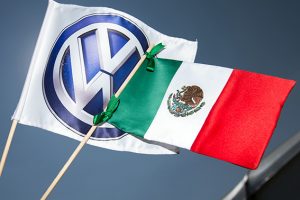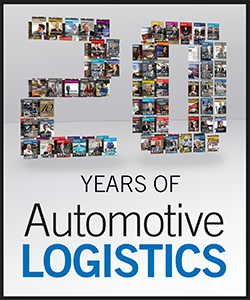The group’s head of group logistics talks about the major changes seen over the past two decades – and why he is optimistic about the future of logistics
 Christopher Ludwig: What are the most prominent differences in managing logistics at a group level for Volkswagen Group today versus 20 years ago?
Christopher Ludwig: What are the most prominent differences in managing logistics at a group level for Volkswagen Group today versus 20 years ago?
Thomas Zernechel: The challenges faced by the group-wide network are growing in line with the increasing size of the network and the changing conditions in which we operate. The most important change is the growing complexity of the supply chain and the occurrence of unforeseen events. Flexibility and crisis management have become core competences for group logistics.
The approach was also absolutely different when we had half the volume and a third as many models. Today, we have completely different steering processes for this huge logistics network. In such a big supply chain, it is not easy to confront potential disruptions, like traffic or weather issues. Stable and robust processes become even more important.
It has also been important to integrate new brands into our network, for example MAN, Scania, Porsche and Ducati. This has been one of the biggest challenges, but now it works very well.
Did you learn new group processes as you gained brands?
Absolutely. One of the advantages was that we have such a range of brands and geographies, from Scandinavia to southern Europe, premium brands to commercial vehicles, each with different environments. Our approach is to take the best from each, and to not just order them to do what the group says. Not every factory needs the same exact processes. We have low-cost country plants with low-cost country logistics, and then we have high-cost processes in Germany, for example. We look for common standards but we also need to be flexible.
How has the group’s changing geography impacted logistics?
Twenty years ago, we focused mainly on Europe. Nowadays, many of our plants are located in other continents. China, Russia, Mexico and India are playing increasingly important roles and we are becoming active in other countries, such as Algeria.
As a general principle, we produce our cars where we can market them and source our materials where we have production facilities. This also leads to changes in logistics structures and processes. As a result, we need to build up and develop logistics know-how in and for these regions. However, this development also offers new opportunities.
Overall, has the cost that logistics represents per vehicle in the total supply chain increased, decreased or stayed the same over the past two decades?
I can’t say how costs have developed in automotive logistics in general. As regards the Volkswagen Group, logistics costs have remained at the same level over the past few years and have even fallen after adjustment for inflation. Effects with an impact on prices, such as labour and ancillary expenses, carriage rates, tolls, multi-stage value streams and long transport distances, were compensated for and optimised. Such measures include more holistic cost assessments when purchasing parts, cross-brand network optimisation and consolidation as well as measures like higher filling and utilisation rates for transport and packaging.
How have cost assessments become more holistic?
Today, the logistics department collaborates more with purchasing, manufacturing and sales to assess the total cost represented by logistics for every decision. In the last years we have significantly increased local production and local sourcing and therefore were able to reduce logistic costs. Nevertheless, we are also looking globally for innovative and cost-efficient solutions.
Have overall lead times in getting vehicles to customers and dealers increased, decreased or stayed the same?
For the group, lead times in logistics processes have been reduced. However, what is more important is the fact that we can react more flexibly to our customers’ wishes; for example, we can make changes even after an order has been placed. The decisive factor for the customer is that we comply with the required delivery date in a binding way, with consistent tracking of orders across our brands.
Supporting that has been one of the biggest changes for us in the past 20 years: we pursue sequential orientation, with daily rather than weekly steering of orders wherever possible. Now, when sales colleagues make changes to orders, we react immediately to make sure we have sufficient parts supply and capacity. The process is especially important for built-to-order vehicles.
Systematic, automatic logistics
What has been the most significant change in IT and software over the past 20 years for the group’s logistics?
The coverage offered by digital support in our logistics process from the supplier to the customer has significantly increased. Data are also made available significantly faster. We are providing digital support for more processes. Now, we are also moving away from monolithic mega-systems to agile micro-services tailored to the requirements of applications. The decisive factor is a uniform database – our system ‘backbone’. This means that data are held in one location and can be accessed from various points throughout the process.
Are many of your systems moving to the cloud?
The main data is in our backbone, and most normal processes are in our own systems. But smaller applications will be in the cloud and will be shared with suppliers and logistics providers, such as the Discovery platform for shipping notifications.
 VW’s new cloud-based IT system, Discovery, aims to increase transparency between suppliers, forwarders and plants
VW’s new cloud-based IT system, Discovery, aims to increase transparency between suppliers, forwarders and plantsHave you seen big improvements in visibility?
In the past we have achieved very good results with track-and-trace, resulting in a significant improvement in transparency. This allows more stable, reliable processes. Digitalisation will provide further potential. For inbound logistics, Discovery will be a new data hub and communications platform combining all activities and information flow relevant to shipments. This allows transparency for all process participants, and efficient communications between plants, suppliers and forwarders.
A growing topic for outbound logistics is the use of in-vehicle telematics to track and communicate with vehicles. Is this relevant for Volkswagen Group?
Absolutely. It will be normal in the future to track cars in this way. We are already discussing the process with our research and development partners.
What IT developments will be most important to your logistics in future?
‘Vehicle assistance systems’ are already providing support both in our private lives and in the shipment of goods. In the near future, there will be rapid growth in ‘logistics assistance systems’. For example, decision-making algorithms will allow fully automated control of replenishment or assess the best options for action in the event of a bottleneck.
We see a number of other important areas that will impact logistics, such as ‘big data’. Increasingly transparent market data or predictive ‘risk maps’ will allow more reliable forecasts across a supply chain and logistics network. This will ensure targeted control of investments in new production capacities, and more effective capacity management in line with demand.
Have you seen a big rise in the automation of logistics operations and processes?
Automation is increasing in all steps of the logistics process but has developed to a different extent in different areas. Manual processes still largely dominate inbound logistics up to the factory gate, for example. Within plants, driverless transport systems, automated unloading systems and self-organising order picking are often already the standard approach. Delivery to the production line and picking at the point of use are areas that are also increasingly automated.
 Automated inventory management will take the effects of digitalisation beyond the physical movement of parts
Automated inventory management will take the effects of digitalisation beyond the physical movement of partsWe are currently making considerable progress in the field of distribution. The robot RAY is a first step in the handling of completed vehicles, which is already in use by the Audi brand. We are also already working to make better use of the capabilities of autonomous vehicles.
What new logistics equipment will play a big role?
Flexible autonomous transport systems and automated universal grippers for order picking are the key topics. Picking is one of the processes with the highest cost and we think this can be automated. For this you need a new generation of grippers with finger-like qualities to take parts from universal packaging in accurate picks. The industry is working on this and I think it will be available in a relatively short time.
Packaging through the years
Has returnable packaging seen a significant increase?
For many years our logistics systems have given priority to the use of returnable packaging in our transport processes. This is beneficial from both economic and environmental points of view. Over the past few years, we have developed a management system that allows us to practice these processes in a cost and investment-oriented way. With cross-brand standardisation our carrier pool today includes more than 20m load carriers, which is continually being renewed and expanded. Our target is to reduce the use of bespoke packaging further.
Have you seen a change in the amount of standardised versus bespoke packaging?
Yes, we observed an increase in bespoke packaging up to 2010. Since then, we have been working on a massive reduction in this number. The share of bespoke packaging in the total pool is currently about 11% and being continually reduced. It is only economically viable to manage our highly diverse material transports and the growing number of different parts handled if we achieve a high degree of packaging standardisation. Shorter lifecycles of our products are also increasing the pressure to generate simple, reusable packaging solutions, which can be used irrespective of the vehicle type. This is why our planners cooperate closely on cross-brand and cross-functional teams for vehicle projects with considerable success.
 Volkswagen has looked to technology innovations to automate parts handling and make it more ergonomic
Volkswagen has looked to technology innovations to automate parts handling and make it more ergonomicWhat changes do you see for packaging in future?
Digitalisation is already having considerable impact on our load carriers, as they can be combined with digital technology to improve transparency, including location and filling levels.But load carriers themselves will also change. Their designs will be significantly optimised using new technology such as virtual reality and animations. We are also working on developing a generation of sustainable load carriers for small parts using innovative, bio-based materials. These are currently in the development phase, and will have benefits in terms of less weight and higher volume capacity.
Staying relevant in the future
How important are sustainability and emissions reduction in your supply chain today compared to the past?
Sustainability is a corporate goal of our group, and group-wide logistics plays a key role in it. Our objective is to optimise all transport or to switch to more environmentally compatible means of transport and ensure maximum capacity utilisation.
For example, traditionally the Volkswagen Group has made strong use of railway systems, with more than 60% of outbound shipments moving by train. The share is mainly in Europe, but has also grown in North America and China. We are continually working to increase rail usage where this is economically viable.
In the analysis of our logistics processes, we also take noise emissions into account. As a result, we have integrated leased Touax rail wagons into the Volkswagen rail network in Europe. This is a special wagon with ‘whisper brakes’ that reduce noise levels by more than 75%, and also allow for a bigger volume for freight shipments. Our rail partner, Deutsche Bahn, is also increasing the use of whisper brakes.
We are also starting to use alternative fuels. From 2019 we will use the first LNG ro-ro ships to North America. We will also soon use LNG trucks together with Scania in our European logistics network. In future, we will increasingly look to electrified vehicles as well.
 VW’s heavy use of rail transport fulfills environmental as well as efficiency aims
VW’s heavy use of rail transport fulfills environmental as well as efficiency aimsWill regulatory changes have a big impact on logistics?
Yes, we will have to react to new regulatory requirements, including the use of different fuels as well as more efforts to use railways. However, if you look at Europe, the rail network is already full and will need more investment. Similar investments are needed, and starting to happen, in other countries, like China, Mexico and India. For China, the ‘One Belt, One Road’ links encouraged by the government could lead us to put more exports on rail between Europe and China.
What skills are most important for a logistics and supply chain manager at your company today compared to 20 years ago?
It is more important than ever for logistics practitioners to think in terms of the entire group, across the boundaries of individual departments.
Within and outside the group, good logistics practitioners need to be networked and increasingly have an affinity for IT. They should be characterised by highly developed communication capabilities in several languages and appropriate social skills. Above all, they should be familiar with the key levers of development, customer order and value addition processes, such as process chains and materials management, among others.
What skills do you think employees will need most in future?
Growing digitalisation calls for new skills, which applies to all departments. Well-trained employees with the right qualifications will be a key factor. New technologies create new products, new processes and new types of cooperation, so it is important to involve employees and to provide the training. We have established a cross-brand initiative within logistics to analyse qualification requirements and to plan and implement the training required. Employees need to be trained to develop a ‘digital view’ and to grasp the opportunities offered.
What capabilities do LSPs need today that differ from the past?
For our logistics partners, we increasingly require digital performance capabilities so that we have the agility needed to benefit together from the opportunities offered by present and future IT innovations. Such digital efficiency is needed to support new platform strategies and data exchange with all relevant partners, for example through the Discovery platform. Providers also need to offer full electronic connectivity, and be able to offer warehouse management and provision as fully automated processes.
 The Konzernlogistik operation recently opened a North American office in Puebla, Mexico
The Konzernlogistik operation recently opened a North American office in Puebla, MexicoCompanies must also be open for new business models, including adapting new technologies, such as those we already know from the consumer industry. Finally, they need to maintain reliability in uncertain times.
Do you see more room for start-ups and disruptors in the automotive logistics industry versus traditional players?
Traditional logistics providers will continue to serve the industry if they are able to develop their processes in an autonomous way, adapting new technology such as software and robots. There are some start-ups with good ideas that also have a chance to get into our processes for the automotive industry. I think it would be a good idea for more logistics providers to partner with these start-ups.
What do you anticipate will be the most significant development for supply chain and logistics over the next decade for Volkswagen?
In cross-brand logistics, digitalisation will bring about the greatest changes and allow a significant reduction in costs, with effects in a number of areas. For example, autonomous movement in all parts of the process chain will be massively expanded and ‘self-organising logistics systems’ – including things such as automated inventory management – based on seamless, transparent process chains, will see increasingly widespread use.
In addition, perceptions of the role of logistics in society will change: in future, mobility concepts for urban areas will allow the combined transportation of people and goods – bringing new challenges and business models for logistics service providers.
How would a shared goods-human concept work for automotive freight?
We are not only thinking about this in terms of automotive parts or finished vehicles. As Konzernlogistik is a service provider within the group, we are also looking beyond our own borders to think about new products, not only for the automotive industry, but also for people in big cities, where there are increasing issues with congestion. Empty cars, buses and taxies parked in the city could be used to move people or freight, for example. We see opportunities for new digital logistics services around new mobility concepts.
Volkswagen Group part 1: Present and prepared for the future
- 1
- 2
 Currently reading
Currently readingVolkswagen Group part 2: Talking ‘then and now’ with head of group logistics, Thomas Zernechel


























![Global[1]](https://d3n5uof8vony13.cloudfront.net/Pictures/web/a/d/s/global1_726550.svgz)














